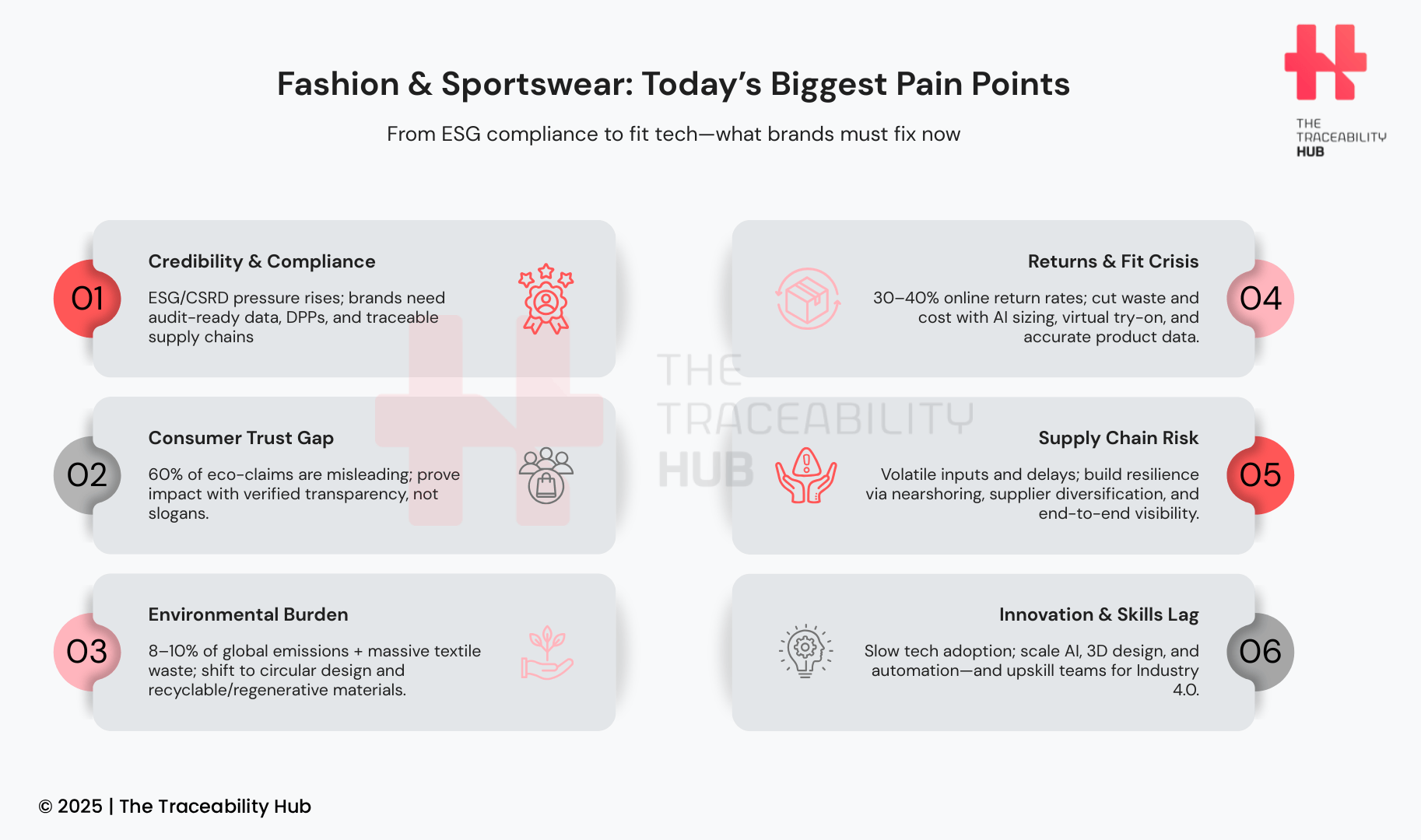The fashion and sportswear industry is undergoing a major transformation driven by shifting consumer behavior, sustainability regulations, and rapid digital transformation.
Global brands face mounting pressure to balance profitability with ethical responsibility while keeping pace with ESG compliance, supply chain traceability, and technology adoption.
The rise of athleisure and sportswear fashion has blurred traditional boundaries between performance wear and lifestyle clothing. This convergence creates new business opportunities but also amplifies existing challenges: supply chain disruptions, stricter sustainability standards, and rising operational costs.
At the same time, the e-commerce boom reshapes retail logistics, introducing high return rates, sizing variability, and growing carbon footprint concerns. To remain competitive, fashion and sportswear companies must innovate quickly while meeting consumer expectations for sustainable materials, ethical sourcing, and transparency.
This article explores the biggest industry pain points and how innovative fashion brands are tackling them, from ESG data challenges to digital product passports (DPPs) and circular fashion models that promote accountability and long-term growth.
Changing Consumer Expectations
Modern fashion consumers are rewriting the rules of engagement. Loyalty no longer stems from celebrity stylists or seasonal collections, it’s rooted in authentic brand values, ethical practices, and purpose-driven storytelling.
From Trend-Following to Value-Driven Shopping
Fashion trends are now evolving faster than ever, but consumer values evolve faster still. Today’s shoppers prioritize sustainable fashion, brand transparency, and social responsibility over fleeting trends.
In this crowded marketplace, fast fashion and premium brands increasingly look alike, eroding differentiation and customer loyalty. This “sameness” dilutes brand equity and turns fashion into a commodity.
The trust gap is now one of the biggest issues in fashion marketing. Consumers, especially Gen Z and Millennials, are skeptical of “green” or “eco-friendly” claims. They demand evidence-based sustainability reporting, not vague promises.
Research by Context Consulting shows that younger shoppers would rather have advanced retail technology, such as virtual try-on tools and fit prediction systems — than discounts. This indicates that digital experience and personalization matter more than price.
For fashion brands, the challenge is clear: rebuilding genuine emotional connections through authentic ESG strategies and transparent communication, not surface-level rebranding.
The Demand for Ethical and Transparent Brands
Modern shoppers, especially in the fashion and sportswear sectors, expect ethical business practices and verifiable sustainability performance. They are quick to call out greenwashing and reward brands that provide measurable impact.
According to the Changing Markets Foundation, 60% of fashion’s eco-claims are misleading or unproven, a statistic that reinforces the urgent need for traceable supply chains and data-driven sustainability metrics.
Edelman Trust Barometer research further highlights fashion as one of the least trusted industries, while Cotton Incorporated reports that 64% of young consumers prefer companies with verified sustainability credentials.
Forward-thinking brands are responding through digital traceability solutions and blockchain product passports that showcase material provenance, labor conditions, and environmental impact in real time.
Examples include:
- Enhanced supply chain traceability systems that visualize multi-tier supplier relationships.
- Blockchain-enabled Digital Product Passports (DPPs) for full product transparency from raw materials to retail.
- IoT-powered live tracking across global fashion supply chains.
Tools like the Higg Index are helping brands measure environmental and social impacts, providing a standardized sustainability language that consumers trust and regulators recognize.
Ultimately, traceability and transparency have become strategic pillars of fashion sustainability, not marketing trends. Brands that invest in circular design, responsible sourcing, and digital accountability will earn long-term loyalty in a skeptical market.
The Italian Fashion Cases
In recent months, the Italian fashion industry has been rocked by a series of judicial investigations and scandals related to labor exploitation, shady subcontracting, and a lack of ethical oversight in the supply chain, even among luxury brands.
The most notable case includes Loro Piana Case, the LVMH group brand, which was placed under judicial administration for alleged irregularities in the supply chain. The investigations revealed the use of irregular labor and subcontracting to companies that violated safety and wage regulations.
But also other brands are involved such as Max Mara, Valentino, Giorgio Armani Operations, Dior, Richemont. The allegations include gang mastering, wages of €4 an hour, and precarious and dangerous working conditions.
The sector is accused of operating with opaque subcontracting chains, where effective oversight of legality and ethics is often lacking. While the Italian government has promised stricter controls, and the unions are calling for a mandatory and transparent traceability system, Italian fashion is probably suffering from a cultural and technological backlog in compliance management.
These scandals are undermining the credibility of Made in Italy fashion system, with negative effects on exports and consumer confidence. Therefore, pressure is growing to adopt tools like Digital Product Passport, smart labels, and blockchain to ensure transparency.
Fashion & Sportswear: Today’s Biggest Pain Points

Sustainability and Environmental Impact
The fashion and sportswear industry is facing its most critical challenge yet, environmental sustainability. While other sectors can gradually shift toward greener practices, fashion sustainability demands immediate, systemic change to ensure the industry’s survival.
Fashion’s Carbon Footprint and Textile Waste
The environmental impact of fashion is staggering. According to UNEP, the fashion industry is responsible for 8–10% of global carbon emissions, ranking among the world’s top polluters. Manufacturing alone contributes over 70% of these emissions, driven by energy-intensive production and complex global supply chains.
The post-production phase is equally damaging. The Ellen MacArthur Foundation reports that fashion generates over 40 million tons of textile waste annually, much of it preventable.
Despite being fully recyclable, less than 1% of cotton textiles were recycled in 2020. Footwear waste compounds the problem, over 2 billion pairs of shoes are discarded every year, with few recycled due to non-recyclable mixed materials like rubber soles bonded to synthetic uppers.
Most clothing ends up in landfills within a year of purchase, driven by fast fashion trends that prioritize speed and cost over longevity and recyclability. This linear model, “take, make, waste”, is incompatible with the circular fashion economy the planet urgently needs.
The Role of Recyclable and Regenerative Materials
A McKinsey & Company report found that 15% of fashion executives now rank sustainability among their top three strategic priorities. This shift is pushing brands to explore recyclable and regenerative materials that reduce their carbon footprint and textile waste.
For instance, Lululemon aims to use 75% recycled polyester in its collections, potentially reducing emissions by up to 45%. Meanwhile, pioneers like Patagonia continue to lead by example, prioritizing planet over profit and demonstrating that sustainable fashion business models can still be profitable. One of the most impactful initiatives of Patagonia is the “Worn Wear program”, which promotes a circular campaign for the reuse, repair, and recycling of old clothes.
However, challenges remain: recycled fabrics are often more expensive than virgin materials, deterring widespread adoption. True transformation requires a design-for-disassembly mindset, rethinking how clothes are made from the start.
To enable circularity in fashion, brands must:
- Design products for easy material recovery at end-of-life
- Minimize use of mixed fibers that hinder recycling
- Simplify construction and stitching for easier disassembly
- Standardize components to support closed-loop recycling systems.
This circular design approach ensures materials stay in use longer and waste stays out of landfills, a key principle of the circular economy for fashion.
On-Demand Manufacturing as a Solution
Beyond materials, on-demand manufacturing offers a game-changing solution to reduce fashion overproduction and carbon emissions. This sustainable production model only manufactures garments after purchase, cutting waste and excess inventory.
Some companies are leading the way, leveraging mobile body measurement technology to create made-to-order clothing that fits each customer perfectly. This approach eliminates sizing errors, reduces returns and shipping emissions, and builds a more sustainable fashion supply chain.
Some mobile tailor apps use AI-driven digital measurements to ensure precision whether shoppers buy online or in-store, blending fashion technology with sustainability.
By embracing on-demand production, digital twin modeling, and data-driven design, brands can drastically reduce waste, improve efficiency, and move closer to achieving net-zero fashion goals.
Circular Fashion Systems and Sustainability Legislation
Achieving real sustainability in fashion requires collaboration across the value chain, from design and sourcing to logistics and end-of-life recovery. Adopting closed-loop systems keeps garments in use through smart design, efficient collection, and advanced sorting for recycling.
New sustainability regulations are accelerating this shift. For example, New York’s Fashion Sustainability and Social Accountability Act mandates greater supply chain transparency, carbon disclosure, and waste reduction across global brands. Similar frameworks in the EU, like ESPR (Ecodesign for Sustainable Products Regulation) and the upcoming Digital Product Passport (DPP), will soon make traceability and recycling mandatory in the fashion industry.
Tomorrow’s leading sustainable fashion brands will be those that balance profitability with environmental responsibility, integrating smart materials, digital manufacturing, and circular fashion design into their core strategy.
The future of fashion sustainability lies in combining innovation, traceability, and eco-conscious design, not as an option, but as a survival imperative.
Returns and Fit Challenges in Online Shopping
Online shopping returns have become a major headache for fashion e-commerce and sportswear brands, with huge financial losses and serious environmental impact. E-commerce has made shopping easier, but it has also created a returns crisis that puts both profits and sustainability goals at risk.
The Scale of Return Problems in Fashion E-Commerce
The pandemic pushed more people to shop online, which led to a concerning spike in fashion e-commerce return rates. The National Retail Federation reports that customers send back 20.8% of all online purchases, a 96% increase since 2020.
The numbers look even worse for fashion retailers. PwC reports that 30–40% of online fashion items get returned. This creates several major problems:
- Higher costs from reverse logistics and processing returns
- More carbon emissions from shipping back and forth
- Wasted products that can’t be resold
- Lower profits on successful sales to cover return expenses
What’s causing this flood of returns in online shopping? The main issue is unclear product details, especially when it comes to fit and style. About 26% of fashion returns happen because clothes don’t fit right or look different from their online pictures. Shoppers can’t try items on first, so they often buy multiple sizes, a behavior known as bracketing, planning to keep just one. This has become normal e-commerce shopping behavior.
Across the fashion industry, this creates huge waste. A single returned piece might travel thousands of miles, need new packaging, and possibly get thrown away, going against the very sustainability goals and ESG commitments these brands try to achieve.
How Fit Technology Is Transforming the Customer’s Experience
Smart fashion retailers are fighting this problem with state-of-the-art fit technology solutions. The most advanced tools lead the way by combining computer vision, 3D body scanning, and machine learning to solve sizing issues and improve online customer experience.
These systems let customers create accurate digital body models from two simple photos. They get specific size recommendations and can see how clothes would look on them through virtual try-on technology. This tackles the main reason why people return clothes, inaccurate sizing.
The numbers prove it works. Brands using these AI-powered fit tools have reduced return rates by up to 40%, making a big difference both financially and environmentally.
These technologies align with what modern shoppers want. Context Consulting found that half of Gen Z and Millennial shoppers would rather have better fashion technology than lower prices. Shoppers value the confidence and ease of virtual try-ons more than small discounts.
This enthusiasm for digital fashion goes beyond just fit solutions. About 71% of consumers say they’d shop more with brands that use augmented reality shopping experiences. Virtual try-on tools let people see how clothes look without changing outfits, offering easy, fun, and personalized digital experiences that today’s customers expect.
These tools also support fashion sustainability goals. Getting the right fit the first time means fewer returns, lower carbon footprint, and less waste from shipping and packaging. It’s rare to find a solution that benefits both customers and the environment.
Regulatory Shifts and Compliance Demands
Regulatory compliance has evolved from a minor concern into a strategic driver for decision-making in the fashion and sportswear industry. Global sustainability regulations, ESG reporting mandates, and traceability requirements are reshaping how companies operate.
Brands now face a complex reality as governments worldwide introduce stricter environmental laws, transparency obligations, and supply chain due diligence rules. This new regulatory landscape demands a full fashion industry transformation toward sustainable production and compliance readiness.
What ESPR and DPP Mean for the Industry
The EU’s Ecodesign for Sustainable Products Regulation (ESPR) marks a revolutionary step in sustainable fashion regulation and eco-design standards. This upcoming law will redefine how fashion and sportswear brands design and market their products, establishing clear rules for durability, repairability, energy efficiency, and chemical safety.
At the center of this framework are Digital Product Passports (DPPs), the cornerstone of product traceability and data transparency in the EU market. These digital IDs store verified information about a product’s materials, origin, environmental footprint, and recyclability potential.
DPPs offer brands a new opportunity to prove sustainability compliance and ethical sourcing while strengthening consumer trust. However, implementing these traceability systems requires robust data infrastructure and blockchain integration, which many companies still lack.
The convergence of ESPR, Digital Product Passports, and sustainability reporting standards signals a new strategic direction for the entire fashion supply chain. Businesses must evolve from isolated green initiatives to holistic, future-ready compliance strategies aligned with EU sustainability policies and ESG requirements.
Brands that delay adaptation risk losing both regulatory alignment and consumer trust. Younger generations, especially Gen Z and Millennials, demand proof of sustainability through verifiable data rather than marketing claims.
How to Prepare for Traceability and Reporting Requirements
Preparing for these new EU compliance regulations requires a comprehensive sustainability approach that touches every area of the business, from design and sourcing to manufacturing and reporting.
Leading brands are already taking action by:
- Building digital data infrastructure to track product information across the entire value chain, from raw materials to end-of-life.
- Redesigning products with circular design principles that enable tracking, reuse, and recycling.
- Strengthening supplier relationships by enforcing ESG reporting and labor transparency requirements.
- Implementing blockchain traceability solutions to verify, secure, and share supply chain data across partners.
Blockchain-powered product passports are emerging as a transformative traceability technology. Some companies are already demonstrating their value in fashion transparency, and the European Union is expected to expand these digital compliance systems widely by 2025.
Beyond technology, brands must rethink their entire compliance management model. In the past, compliance was treated as a separate department. Now, regulatory compliance must be integrated directly into product development, supply chain operations, and marketing strategies.
As global supply chains become increasingly complex, ensuring ethical sourcing, real-time visibility, and traceability compliance across multi-tier networks is a growing challenge.
Standardized tools help simplify this complexity. The Higg Index, for example, offers a unified framework to measure environmental impact, social responsibility, and ESG performance throughout a product’s lifecycle, enabling consistent and comparable sustainability reporting.
Supply Chain Complexity and Risk
Supply chain management has become one of the biggest vulnerabilities for the fashion and sportswear industry. Traditional global sourcing models have revealed major weaknesses in what was once considered an efficient supply network. Today’s supply chain complexity exposes brands to greater risks, from raw material shortages to logistics disruptions and rising operational costs.
Why Global Supply Chains are Under Stress
The fashion supply chain faces unprecedented global disruption, with multiple risk factors colliding at once. Material shortages, labor gaps, delivery delays, and the ongoing energy crisis have created a perfect storm that threatens both profitability and performance.
These supply chain bottlenecks are driving up manufacturing and distribution costs, hurting apparel brands’ margins and slowing growth.
Raw material volatility continues to escalate in the fashion and sportswear industry. Price fluctuations for cotton, polyester, and synthetic fibers are increasingly unpredictable, complicating cost forecasting and production planning.
On top of this, geopolitical tensions and port congestion cause widespread shipping delays that ripple through the entire fashion supply chain network. Even small disruptions can quickly snowball into major inventory management issues, leading to lost sales and wasted resources.
Brands now find themselves caught between rising operational costs and consumer pressure to keep prices competitive. This creates several challenges:
- Margin erosion across product categories
- Slower fashion innovation due to financial strain
- Reduced investment in sustainability initiatives and ESG goals
Beyond financial pressure, supply chain complexity itself has become a strategic risk. As global networks expand, brands must manage multi-tier supplier relationships and ensure real-time data visibility, something many companies still struggle to achieve at scale.
According to McKinsey & Company, global fashion industry growth is expected to remain in the low single digits through 2025. This uneven growth across regions makes supply planning and demand forecasting increasingly challenging.
Strategies for Building Resilience and Agility
Supply Chain Visibility and Transparency and End-to-end visibility are now a non-negotiable for resilience and compliance, to reduce exposure to tariff shocks, political instability, and logistics bottlenecks.
Smart fashion and sportswear companies are rethinking their sourcing strategies to prioritize resilience and agility over cost-cutting.
Nearshoring has emerged as a key strategy for building resilient supply chains. Moving manufacturing closer to the end market helps brands minimize logistics risks, avoid supply bottlenecks, reduce shipping emissions, and ensure faster delivery times. While nearshoring requires upfront investment, it offers major long-term benefits in efficiency and flexibility.
Brands are shifting production away from single-region dependency (e.g., China) to multi-country sourcing across Southeast Asia, Eastern Europe, and Latin America. Supplier diversification is another critical resilience strategy. Relying on a single supplier or region has proven too risky. Working with multiple partners across geographies provides risk mitigation against local disruptions and enhances supply continuity.
Leading brands are also investing in digital supply chain technologies to improve visibility and responsiveness.
Their tools include:
- Advanced inventory management systems that optimize stock levels and reduce waste
- Predictive analytics for demand forecasting and real-time risk detection
- Blockchain solutions for traceability, product authentication, and ethical sourcing verification
The best supply chain strategies strike a balance between just-in-time efficiency and just-in-case preparedness. This hybrid model maintains performance in stable conditions while safeguarding against unexpected supply chain disruptions.
The future of fashion supply chains will not revert to old models. Instead, new frameworks must anticipate and prepare for constant uncertainty, embedding resilience and traceability at their core.
Companies must stop viewing supply chains merely as cost centers and start treating them as strategic assets that create competitive advantage through agility, visibility, and sustainability.
In this rapidly evolving landscape, successful brands share one defining trait: they have elevated supply chain management to a C-suite priority, integrating it into product development, pricing strategy, and sustainability planning, positioning resilience as the foundation of fashion’s digital transformation.
The Innovation Gap in Fashion and Sportswear
Innovation and digital transformation remain the weakest points of the fashion and sportswear industry. Despite being one of the world’s most creative sectors, many brands still treat fashion technology as an afterthought rather than a competitive necessity.
The industry now stands at a critical turning point, where AI-powered systems, digital fashion design, and data-driven operations will determine which brands succeed and which fade into irrelevance.
Why Digital Transformation is Lagging
One of the biggest challenges in the fashion industry’s digital transformation is its slow and fragmented adoption of state-of-the-art solutions. Advanced tools like traceability platforms, 3D design software, and AI-driven demand planning systems already exist, yet implementation across the sector remains inconsistent.
Many organizations still view digital transformation as a marketing initiative rather than a core operational strategy. This outdated mindset creates real risk as environmental regulations, ESG compliance requirements, and consumer expectations accelerate.
The cost of doing nothing grows each day. Without investment in fashion innovation, automation, and digital supply chain visibility, brands risk falling behind competitors that use AI, blockchain, and data analytics to drive efficiency, transparency, and sustainability.
The Need for Upskilling and Workforce Strategy
The rise of smart manufacturing and automation in fashion production makes a new workforce strategy essential. Robotics and AI-powered machines are increasingly handling repetitive tasks, from cutting and sewing to finishing and quality control, delivering major improvements in efficiency, accuracy, and cost reduction.
However, this digital shift raises urgent questions about the future of fashion’s workforce. Success depends on balancing innovation with inclusion through reskilling and upskilling programs.
Companies must prepare employees at every level, from designers and pattern makers to factory operators and supply chain managers, to work effectively with new AI technologies, digital design platforms, and automation tools.
The goal isn’t to replace people, but to empower them to collaborate with intelligent systems and unlock the next phase of Industry 4.0 in fashion manufacturing.
How AI and Automation Can Propel Future Development
The future of fashion and sportswear innovation will depend on how well brands integrate AI, data, and automation into every stage of the product lifecycle, from design and forecasting to production and retail and regulations compliance.
Artificial intelligence in fashion is transforming product design, material innovation, and sustainability tracking. Predictive analytics can anticipate demand, reduce overproduction, and cut waste, all while improving margins and environmental performance.
Consumers are also driving this transformation. Half of Gen Z and Millennial shoppers say they prefer brands that use more fashion technology in retail, from AI personalization to augmented reality shopping experiences. In fact, 71% of consumers would shop more frequently with brands offering AR try-on tools or immersive digital fashion experiences.
The innovation gap across the industry requires a new mindset. Technology is no longer an optional upgrade, it is the foundation of a reimagined business model built on efficiency, transparency, and sustainability.
How Brands Can Win the Sustainability and Technology Race
Fashion and sportswear brands face new challenges that need quick action and smart changes. The industry has reached a turning point where old business models aren’t enough anymore. This piece looks at several connected problems that affect both 20-year-old players and new brands.
People now shop differently, focusing more on value. On top of that, sustainability has become crucial as fashion’s huge environmental impact becomes harder to ignore. E-commerce brings new chances but also creates a returns problem that hurts profits and green initiatives.
New rules like ESPR and Digital Product Passports will change how companies develop, market, and track their products. Recent global problems have shown why brands need stronger, more varied supply sources. Many companies still treat technology as an extra feature instead of a must-have tool.
Smart brands see these challenges as signs that the whole industry needs to change. Companies that win big are the ones that accept new ideas on many fronts at once. They redesign products to be sustainable, use better fit technology, build strong tracking systems, vary their supply chains, and speed up their digital progress.
Success means balancing today’s needs with tomorrow’s goals. Companies should work on current problems while creating new business approaches that focus on being open, reusable, and digital.
As the recent cases have shown, the risks are real. Companies that don’t change might lose customers, struggle with new rules, and face supply problems. But those who guide themselves through these challenges will come out stronger and ready to succeed in a world that values real purpose, new technology, and quick thinking.
These big challenges bring equally big chances. The brands that will lead fashion and sportswear tomorrow are the ones that see industry problems as stepping stones to real, lasting change.
Read more: Production Traceability as a Competitive Advantage






